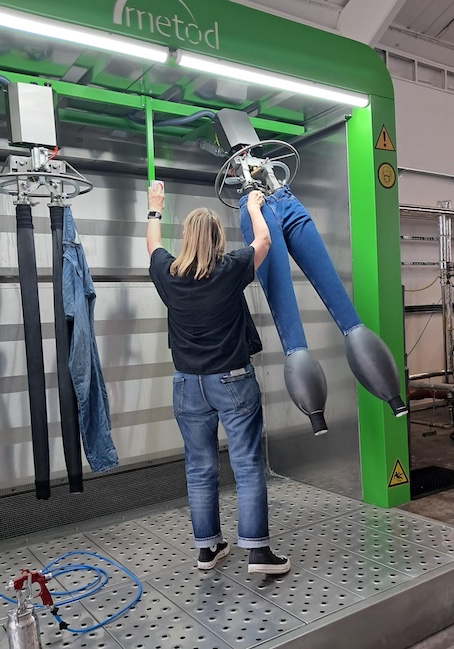Repair & Reprocessing Services in Fashion: A Circular Strategy Gaining Momentum

29-08-2025
UK Spotlight: Repair and Reprocessing Gaining Momentum
Increasingly, UK fashion brands are embedding repair and reprocessing services into their business models as part of their sustainability and circular economy strategies. These efforts are driven by evolving consumer expectations, regulatory pressures, and a growing desire to add value to existing products.
- Marks & Spencer (M&S) has collaborated with the Sojo app to offer “Fixed by Sojo”—professional repair services like zip replacements and knit mending, alongside educational content encouraging DIY repairs via online tutorials.
- John Lewis is rolling out expanded in-store repair and tailoring services in partnership with Johnsons, a Timpson Group company, complementing secondhand initiatives and recycling programs and offering loyalty rewards for repair usage.
- LaundRe: Introducing a powerful new dimension—reprocessing—LaundRe, based in East London, offers innovative circular solutions for denim. It refines unsold or raw stock using advanced technologies—laser, ozone, and nebulising finishes—to create fresh, full-price-ready products. Key services include:
- ReFinish: Applying fresh washes or graphic finishes to unsold denim to recapture value and reposition stock.
- ReShoring: Enabling UK-based finishing of imported unfinished jeans, supporting on-demand production in flexible quantities to reduce inventory risk.
- ReEducate: Hosting workshops and educational programs—from designers to students—to build industry knowledge on sustainable wash technology, laser design, and responsible product engineering.
- These innovations deliver remarkable environmental benefits—up to 90% less water usage, 75% lower CO₂ emissions, 80% less energy, and 90% less textile waste—reinforcing the impact potential of reprocessing strategies.
- Fashion-Enter Ltd, North London-based social enterprise and garment manufacturer. Fashion-Enter provides industrial capacity for LaundRe’s reprocessing orders and has already completed significant commercial projects for brands including Gymshark and N Brown Group. This partnership not only supports domestic circular production but also showcases how repair and reprocessing can be scaled for mainstream and performance apparel brands.
According to WRAP (Waste and Resources Action Programme), extending a garment’s lifespan by just nine months can reduce its environmental footprint by up to 30%, and repair services demonstrate high displacement rates—with 82.2% of repairs preventing the purchase of new items—making them one of the most effective circular strategies available.

(Denim reprocessing at LaundRe)
France & EU: Policy-Driven Circularity Meets Innovation
France continues to lead with policy innovation—its Anti-Waste Law for a Circular Economy introduced in 2023 includes a “repair bonus”, reimbursing a portion of repair costs. This approach incentivises both consumers and businesses to prioritise longevity and repairability.
Platforms like Vestiaire Collective drive high-impact recommerce, partnering with brands such as Chloé and Burberry to resell authenticated luxury pieces. The platform reports it prevents three times more CO₂ emissions than it generates, highlighting the effectiveness of resale and repair models.
Why Repair and Reprocessing Matter Now
- Consumer Expectations: Sustainability, uniqueness, and durability drive consumer interest. Trends like visible mending reflect a growing cultural appreciation for worn-with character and personal narrative.
- Environmental Impact: Repair and reprocessing dramatically extend product life, delay landfill disposal, and reduce the need for new production. With fashion responsible for up to 10% of global carbon emissions, these models are essential to decarbonisation.
- Regulatory Alignment: Both the UK and EU are advancing Extended Producer Responsibility (EPR) frameworks, pushing brands to assume lifecycle accountability. Incorporating repair and reprocessing services proactively supports compliance and enhances ESG transparency.
- Business Model Diversification: Repair and reprocessing services deepen brand engagement, create after-sales value, and align with consumer demographics like Gen Z and Millennials who prioritise ethical consumption.

(Reprocessing trousers for Brown at Fashion-Enter Ltd)
Challenges Ahead
- Scaling Specialised Skills: High-quality repair and reprocessing require skilled labor and technical infrastructure—expensive and resource-intensive to scale.
- Perceived Value: Fast fashion has conditioned consumers toward low-cost replacement. Brands must shift perceptions—presenting repair and reprocessing as added value, not compromise.
- Infrastructure and Investment: Developing reprocessing capacity requires significant investment in equipment, training, and logistics. Partnerships, such as that between LaundRe and stitching social enterprise Fashion-Enter Ltd, showcase how collaboration can bridge gaps.
Embracing a Repair-First, Reprocessing-Ready Future
The fashion industry is entering a pivotal moment—repair and reprocessing are no longer fringe concepts but fundamental components of sustainable and resilient business models. In the UK, pioneers like LaundRe offer tangible solutions for circularity through technology and education, while legacy retailers and policy frameworks help shape systemic change. France’s policy-forward stance propels the industry forward, demonstrating how public and private collaboration can redefine value in fashion.
Sources:























